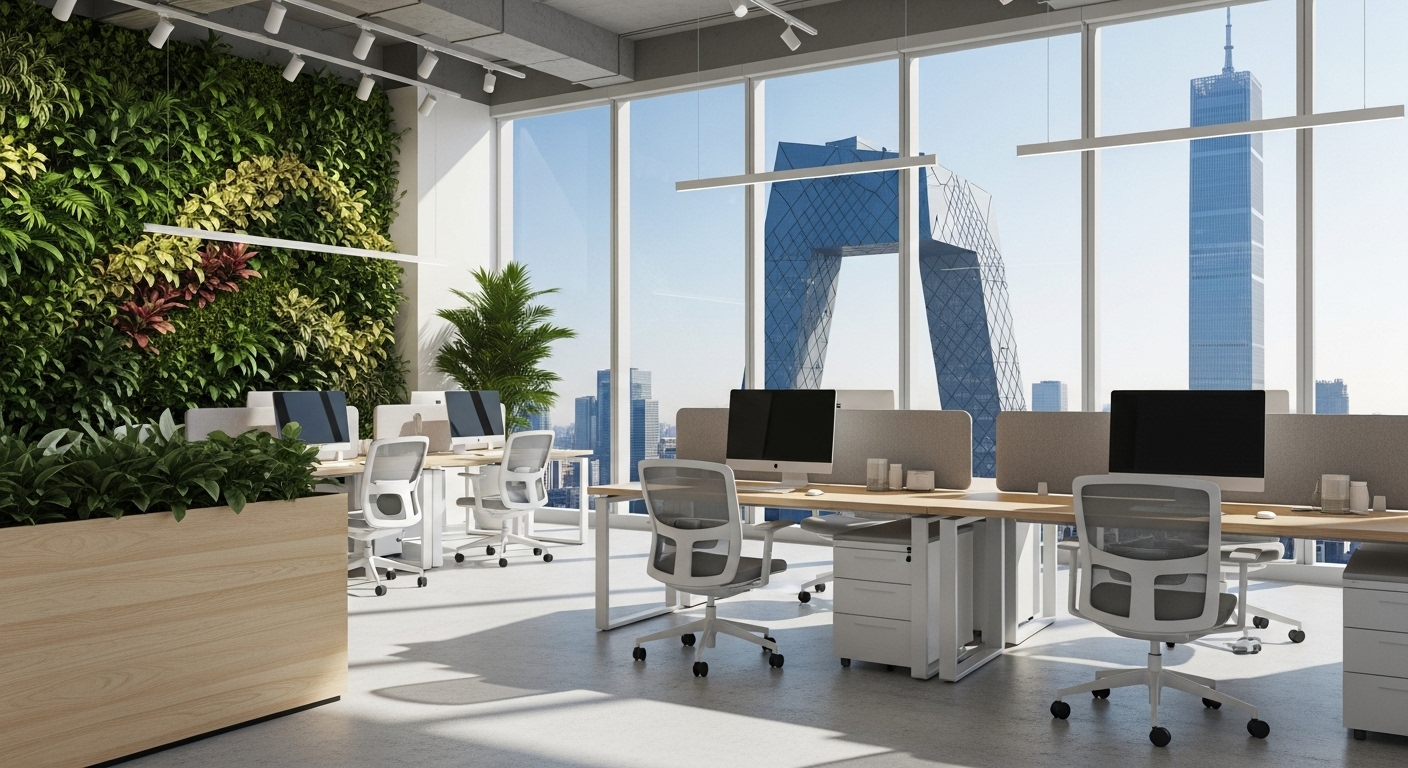The decision of where your team will work has evolved from a simple logistical choice to one of the most defining strategic questions a business can ask. In a post-pandemic world, the ‘office’ is no longer a monolith. Founders and leaders are now faced with what can be called the ‘Workspace Trilemma’: committing to a long-term traditional lease, embracing the agility of flexible spaces, or dissolving physical boundaries entirely with a remote-first model. Each path offers a distinct set of benefits and carries significant trade-offs that impact everything from your balance sheet to your company culture. This guide is designed to cut through the noise, offering a clear, practical framework for analyzing your options. We will dissect the financial implications, cultural impact, and operational realities of traditional leases, flexible offices, and fully remote setups, empowering you to make an intentional choice that aligns with your company’s unique DNA and growth trajectory.
Decoding the Traditional Lease: The Commitment Model
The traditional commercial lease is the long-standing bedrock of corporate real estate. It involves signing a multi-year contract (typically 3-10 years) for a fixed amount of square footage in a specific building. This model offers the ultimate level of control and stability. You have a blank canvas to design a space that is a pure reflection of your brand identity, from the layout and furniture to the technology and sensory details. For established companies with predictable headcount and a strong need for a physical ‘center of gravity,’ a lease can be a powerful cultural anchor. It provides a permanent home that fosters a sense of belonging and permanence for employees and presents a stable, impressive front to clients and investors. Over the long term, the cost per square foot can also be more economical than flexible alternatives. However, this control comes at a steep price. The primary drawback is a profound lack of flexibility. If your team shrinks or grows faster than anticipated, you are stuck with either wasted space or costly growing pains. The upfront capital expenditure (CapEx) can be staggering, encompassing not just security deposits but also extensive build-out costs, furniture, IT infrastructure, and brokerage fees. Furthermore, the base rent is just the beginning; you are also responsible for operating expenses, utilities, maintenance, and insurance, which can add significant and sometimes unpredictable costs to your monthly budget. This model is best suited for mature businesses that value stability over agility and have the capital and confidence to invest in a long-term physical footprint.
Embracing Agility: The Rise of Flexible Workspaces
Flexible workspaces, a category that includes coworking spaces, serviced offices, and on-demand suites, have fundamentally disrupted the commercial real estate market by prioritizing agility over permanence. Instead of a long-term lease, businesses typically sign a membership or license agreement for a period as short as one month. This model drastically lowers the barrier to entry by eliminating most upfront capital expenditures. You’re not paying for a build-out, furniture, or setting up internet; you’re paying a predictable, all-inclusive monthly fee that covers a ready-to-use workspace, high-speed Wi-Fi, utilities, cleaning, and often a host of premium amenities like coffee, meeting rooms, and event spaces. This ‘space-as-a-service’ approach allows for incredible scalability. A startup can begin with two desks and seamlessly scale up to a private office for twenty as the team grows, without the friction of lease negotiations or relocation. This makes flexible spaces ideal for startups, scale-ups, and companies testing new markets. The built-in community also offers invaluable networking opportunities.
As noted by a recent study from Deskmag, 84% of coworking members report being more engaged and motivated since joining.
However, flexibility has its own set of trade-offs. The cost per employee is often higher than a long-term lease, reflecting the premium paid for convenience and short-term commitment. Brand presence can be diluted, as you are operating within a space that has its own distinct brand and is shared with other companies. While private offices are available, the inherent density and communal nature of these spaces can lead to more noise and distractions, which may not be suitable for teams requiring deep, focused work or high levels of confidentiality.
The Boundaryless Office: Assessing the Fully Remote Model
The fully remote model represents the ultimate expression of workplace flexibility, eliminating the need for a centralized physical office entirely. Its most significant advantage is the radical expansion of the talent pool. By removing geographic constraints, companies can hire the best person for the job, regardless of where they live. This can be a game-changing competitive advantage, particularly for accessing specialized skills. The financial benefits are equally compelling. Erasing a commercial lease from the balance sheet is the single largest cost-saving measure a company can take, freeing up capital that can be reinvested into growth, talent, or product development. For employees, the benefits of autonomy, zero commute time, and a better work-life balance can lead to higher satisfaction and retention. Yet, running a successful remote company is a complex operational challenge. Building and maintaining a cohesive company culture without a shared physical space requires immense intentionality. Communication must become more structured and deliberate, relying on a robust stack of digital tools and meticulously planned virtual rituals. There are also risks of employee isolation, burnout from an ‘always-on’ culture, and significant challenges in facilitating the kind of spontaneous collaboration and mentorship that happens organically in an office. Furthermore, the costs don’t disappear entirely; they simply shift. Companies may need to invest more in cybersecurity, provide stipends for home office setups, and budget for regular in-person team retreats to foster connection and alignment. The remote model is best for digitally native companies with a strong culture of trust and documentation, who are willing to invest heavily in the operational backbone required to make it succeed.
The Financial Factor: A Cost-Benefit Analysis Beyond Rent
When comparing workspace options, looking at the monthly rent or membership fee is just scratching the surface. A true cost-benefit analysis requires calculating the Total Cost of Ownership (TCO) for each model. For a traditional lease, the TCO must include not only the base rent but also the amortized cost of the initial build-out, furniture, and IT cabling over the lease term. You must also factor in recurring operational expenses (OpEx) like property taxes, insurance, utilities, maintenance, and cleaning—costs that are often bundled into a single fee in a flexible space. In contrast, the TCO for a flexible workspace is simpler, primarily consisting of the monthly membership fee. However, it’s crucial to analyze what that fee includes and what it doesn’t, such as meeting room credits, printing, or mail services. For a fully remote model, the TCO shifts from real estate to people and technology. Key costs include employee stipends for home offices and internet, the expense of providing standardized tech equipment, robust cybersecurity software, and the significant cost of flying the entire company in for periodic retreats. A critical metric to consider is the ‘cost per employee’ versus the traditional ‘cost per square foot.’ A lease might seem cheaper per square foot, but if you have a hybrid team and the office is only at 50% capacity on any given day, your effective cost per employee present can skyrocket. Flexible and remote models offer a more direct correlation between cost and active headcount, providing greater financial efficiency for non-traditional work styles.
Culture and Collaboration: Aligning Space with Team Dynamics
Your workspace is not just a place to work; it is a physical (or digital) manifestation of your company’s culture. Each model in the trilemma shapes team dynamics in profoundly different ways. A traditional lease offers a powerful, centralized hub for culture. It’s a space you control, where you can embed your values into the very architecture and design, creating a consistent, immersive brand experience that reinforces a shared identity. It naturally facilitates spontaneous, face-to-face collaboration—the ‘water cooler’ moments that can spark innovation. A flexible workspace introduces a different dynamic. While it may be harder to create a distinct company-branded environment, it immerses your team in a broader ecosystem of innovators and professionals. This can foster a dynamic, externally-focused culture and lead to serendipitous partnerships. However, leaders must be more deliberate in carving out their own team’s cultural rituals within the larger community. The fully remote model demands the most intentional approach to culture and collaboration. With no shared physical space, culture must be actively built and maintained through digital channels and processes. This means crystal-clear documentation, asynchronous communication protocols, and regular, structured virtual social events. Collaboration shifts from spontaneous to scheduled, requiring greater discipline. Leaders must actively work to combat isolation and ensure that opportunities for mentorship and team bonding are created, often through a combination of sophisticated digital tools and planned in-person gatherings.
Making the Decision: A Strategic Checklist for Your Business
Choosing the right path in the workspace trilemma requires a clear-eyed assessment of your company’s specific needs, stage, and goals. There is no universally correct answer, only the answer that is right for you right now. Before making a commitment, work through this strategic checklist with your leadership team. First, analyze your Headcount & Growth Trajectory: Is your growth predictable enough to commit to a five-year lease, or do you need the ability to scale up or down on a monthly basis? Second, evaluate your Financial Position: Do you have the upfront capital for a lease build-out, or is a lower-risk, operational expense model a better fit for your cash flow? Third, define your Brand & Client Experience: How important is a dedicated, branded physical headquarters for impressing clients and reinforcing your company’s identity? Fourth, consider your Team’s Work Style: Does your team thrive on in-person, spontaneous collaboration, or do they require quiet, focused environments? Could their needs be met by a mix of home and office? Finally, review your Talent Strategy: Are you competing for local talent in a specific hub, or is your primary goal to access the best talent globally, irrespective of location? Answering these questions honestly will illuminate the path that best aligns your workspace with your overarching business strategy.
Conclusion
The ‘Workspace Trilemma’ presents a pivotal decision point for modern founders. It’s a choice between the stability and brand control of a traditional lease, the agility and low-entry cost of a flexible workspace, and the unparalleled freedom and talent access of a fully remote model. As we’ve explored, each option carries a unique financial, cultural, and operational fingerprint. The traditional lease acts as a powerful anchor for established companies with predictable futures. Flexible spaces offer a dynamic, scalable platform for startups and businesses in transition. A remote-first approach provides a boundaryless framework for companies that prioritize talent and operational efficiency above all else. Ultimately, the optimal choice is not about following a trend but about deep introspection. It requires a thorough analysis of your company’s growth stage, financial realities, cultural aspirations, and operational needs. The future of work is not about declaring one model superior to others; it’s about making an intentional, strategic choice that turns your workspace—wherever it may be—into a competitive advantage that propels your business forward.





